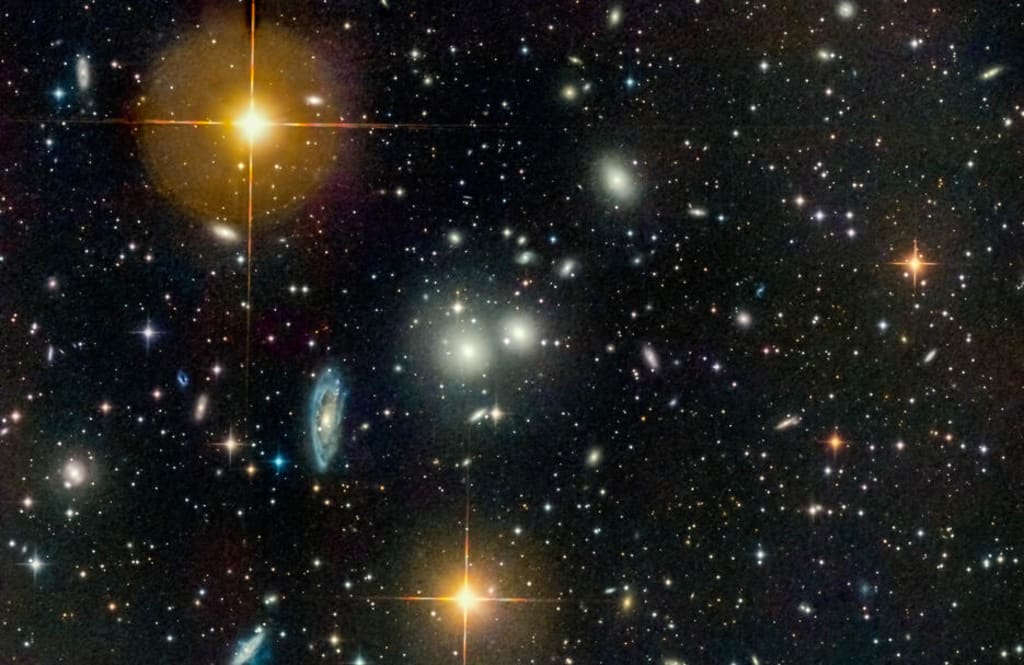The Blackness of Space
Black is black. But not quite, really.

Black is black. But not quite, really.
The background of space is not black. Aside from the noise, there is a faint signal. There is light from many sources in the sky background. These sources included sky glow and emission from other nearby objects.
The cosmic microwave background (CMB, CMBR) is microwave radiation that fills all space.
It is a remnant that provides an important source of data on the primordial universe.[1] With a standard optical telescope, the background space between stars and galaxies is almost completely dark. However, a sufficiently sensitive radio telescope detects a faint background glow that is almost uniform and is not associated with any star, galaxy, or other object. This glow is strongest in the microwave region of the radio spectrum. The accidental discovery of the CMB in 1965 by American radio astronomers Arno Penzias and Robert Wilson was the culmination of work initiated in the 1940s.[2][3]
CMB is landmark evidence of the Big Bang theory for the origin of the universe. In the Big Bang cosmological models, during the earliest periods the universe was filled with an opaque fog of dense, hot plasma of sub-atomic particles. As the universe expanded, this plasma cooled to the point where protons and electrons combined to form neutral atoms of mostly hydrogen. Unlike the plasma, these atoms could not scatter thermal radiation by Thomson scattering, and so the universe became transparent.[4] Known as the recombination epoch, this decoupling event released photons to travel freely through space – sometimes referred to as relic radiation.[1] However, the photons have grown less energetic since the expansion of space causes their wavelength to increase. The surface of last scattering refers to a shell at the right distance in space so photons are now received that were originally emitted at the time of decoupling.
The CMB is not completely smooth and uniform, showing a faint anisotropy that can be mapped by sensitive detectors. Ground and space-based experiments such as COBE and WMAP have been used to measure these temperature inhomogeneties. The anisotropy structure is determined by various interactions of matter and photons up to the point of decoupling, which results in a characteristic lumpy pattern that varies with angular scale. The distribution of the anisotrophy across the sky has frequency components that can be represented by a power spectrum displaying a sequence of peaks and valleys. The peak values of this spectrum hold important information about the physical properties of the early universe: the first peak determines the overall curvature of the universe, while the second and third peak detail the density of normal matter and so-called dark matter, respectively. Extracting fine details from the CMB data can be challenging, since the emission has undergone modification by foreground features such as galaxy clusters. ~Wikipedia
One mistake new astrophotographers make is to make the black of space pure black. A pixel value of zero is pure black (pure white = 255). This can happen by clipping the black values during a stretch or by increased contrast. This makes the black darker and the light lighter, but in the process, you lose data. These are the pixels that contain values but are thrown away when clipped.
Some of the data that gets thrown away may be faint nebulosity.
Astrophotographers should strive to keep as much actual data as possible,
and sometimes the deep black of space needs to be lighter than black.
One technique that can be applied is changing levels to change the black point.
Examine the pixel values, and as stated, it should not be zero, nor should it be set too high. A good starting value is around 30 in each of the RGB channels.
The goal is to get the background as dark as possible without losing the faint signal.
A pure black sky may be our mental picture of deep space, but it does not represent reality and will tend to look unnatural and over processed.
So, keep it on the lighter side.
#### 08JUL2021
THE HYDRA CLUSTER ABELL 1060 - PRO DATA SET
Abell 1060
The Hydra Cluster is a galaxy cluster that contains 157 bright galaxies, appearing in the constellation Hydra. The cluster spans about ten million light-years and has an unusually high proportion of dark matter. The cluster is part of the Hydra-Centaurus Supercluster located 158 million light-years from Earth. Wikipedia
Number of galaxies: 157
Credits
Pro Dataset by Alex Curry; Processing- Jim DeLillo
This blog post was originally published in our Telescope Live Facebook Community.
The Community represents Telescope Live's virtual living room, where people exchange ideas and questions about astrophotography and astronomy.
Join the conversation now to find out more about astrophotography and to improve your observation and post-processing skills!
Be sure to read Jim Delillo's other featured stories on Vocal
You can write for Vocal, too– Join Here
Jim DeLillo is an ambassador and admin for TelescopeLive
About the Creator
Jim DeLillo
Jim DeLillo writes about tech, science, and travel. He is also an adventure photographer specializing in transporting imagery and descriptive narrative.






Comments
There are no comments for this story
Be the first to respond and start the conversation.